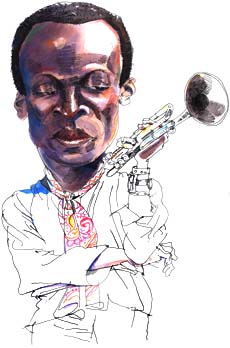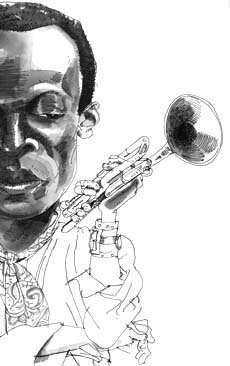Jazz Democracy
Rediscovering the Miles Davis Quintet.
The Complete Columbia Studio Recordings of the Miles Davis Quintet, January 1965-June 1968
Columbia/Legacy
$109.98

In the mid-'60s, Miles Davis met a teen-age drummer who said to him, "Man, why don't you practice?" If the drummer, Tony Williams, hadn't been such a Wunderkind (or "motherfucker," Davis' preferred term), Davis, who was an amateur boxer, might have taught him another kind of lesson. Instead, Davis listened--and followed his advice. Davis tells this story in his autobiography, Miles, and it speaks volumes about his rapport with Williams and the other members of his mid-'60s quintet. It's a commonplace that jazz is the musical expression of American democracy. The unfortunate truth is that jazz more often resembles the daytime talk show: Everyone gets his or her say before the floor passes to the next soloist. The Davis quintet was the rare exception, a luminous example of participatory democracy in jazz.
Columbia has just released the Davis quintet's studio work in a six-CD box set, and it's remarkable how well the music has aged. Here is group improvisation at its most glorious, a conversation between five artists respectful of each other's voices, listening and responding to one another as equals in interplay as dense as a Bartók string quartet, yet still somehow managing to swing. (Click for a couple of small quibbles with the way the box set was put together.)
When Davis formed this band, he had racked up an enviable series of accomplishments. He had performed alongside Charlie Parker, led a marvelous quintet with John Coltrane, and collaborated with Gil Evans on such jazz orchestral arrangements as Sketches of Spain and Porgy and Bess. Davis' 1959 sextet recording, Kind of Blue, became, with its haikulike lyricism, synonymous with cool and provided a soundtrack for nearly every party with intellectual pretensions. More than any other jazz musician of the day, Davis captivated the paparazzi, which faithfully reported on his goings-on, his taste for Italian suits, and his richly cultivated contempt for whites who didn't get it.
But Davis was in a creative slump in the early '60s. He couldn't keep a band together, and he was being outpaced by younger players, such as pianist Cecil Taylor and saxophonist Ornette Coleman, who wanted to liberate jazz from harmonic conventions. Unlike his former sideman Coltrane, who aligned himself with the avant-garde and ultimately became its prophet, Davis sought a middle ground between improvisatory freedom and adherence to form.
He found it with the young musicians who formed his quintet in 1965. With Wayne Shorter on tenor saxophone, Herbie Hancock on piano, Ron Carter on bass, and Williams on drums, Davis had a dream team, and the quintet's music is as much a display of their talent as it is of Davis'. Williams, who had played on landmark sessions with reedmen Eric Dolphy and Jacky McLean, accented the backbeat in the drums and played just a little above everyone else, creating a polyrhythmic, vaguely African template for his band mates. Shorter, an alumnus of Art Blakey's Jazz Messengers, complemented Davis with his elegantly fractured, bagatellelike style of phrasing. Hancock, a favored pianist in Blue Note's stable, was the most versatile of keyboardists. He could play in a hushed, romantic style, then plunge, at a moment's notice, into fiery, Latin-flavored syncopation. And Carter supplied the group with a harmonic center, becoming, in Williams' words, its "checkpoint Charlie."
The quintet released six studio recordings between 1965 and 1968: E.S.P. (1965), Miles Smiles (1966), Sorcerer (1967), Nefertiti (1967), Miles in the Sky (1968), and Filles de Kilimanjaro (1968). (Water Babies and Circle in the Round, which were also recorded in this period, were released in the mid-'70s.) It is stirring, complex music, as exploratory as any of its era. Incredibly, hardly anyone recognized this until the late '70s, when the quintet's work was adopted as a model by young musicians such as Wynton Marsalis. The reason is simple. In the revolutionary age of free jazz, with its joyful defiance of form and radical embrace of pure sound, the Davis quintet seemed just a bit too polished. Despite Davis' well-known militancy, he didn't care to set his music to civil rights poetry or to compose preacherly anthems in the manner of Coltrane.
T hat said, the music bears the unmistakable imprint of the '60s. The hierarchy separating the leaders and the led, teachers and students, was dissolving in Davis' music, as it was everywhere else. Davis' apprentices kept their master on his toes--challenging him to take risks and to experiment with more open forms. Davis all but scrapped the traditional boundary between foreground (improvising soloists) and background (rhythm section). The quintet's music was built from the bottom up, assertively declaring jazz's African lineage. Williams is the busiest of the musicians, dusting every corner with percussion confetti. On the gorgeous title track of Nefertiti, for instance, he is the leading soloist; Davis and Shorter repeat the pensive theme hypnotically, without soloing, making this tune arguably one of the first statements of American minimalism. Inspired by Williams, Davis adopted a more percussive style of improvising, throwing aggressive, staccato darts at the rhythm section. There's an edginess, a tough guy's melancholy, to Davis' sound. Gone is the balladeer of earlier years.
The material was also new. Everyone in the group was composing, especially Shorter, whose strangely floating, Moorish-inflected melodies are among the most mesmerizing in jazz. Shorter's compositions are like caramel cages: They sound so fragile you're amazed they hold together. But, in fact, they're quite pliable, lending themselves to dramatic shifts in tempo and voicing. Listen, for example, to the haunting "Masqualero" from Sorcerer, a 22 measure composition in which Hancock and Carter adapt the song's shape to the soloists, Davis and Shorter. It's form as a living, organic process.

W ithin a few years, Davis grew tired of acoustic jazz, and his final sessions with the quintet are restless, transitional works that point the way ahead. After the release of Nefertiti, Davis began experimenting with the electric instruments that would consume the remainder of his career--to the horror of many in the jazz community. He invited guitarists George Benson and Joe Beck into the studio, and he had Hancock perform on a Fender Rhodes electric piano (and even on celesta). Davis' writing assumed a pared down pop sensibility on tunes like "Stuff," from Miles in the Sky. It's a cocky funk tune that wouldn't be worth its 17 minutes if the soloists weren't Miles Davis and Wayne Shorter.
Were Davis'electric instruments and simpler forms an opportunistic concession to pop? It's true that some of his later work sounded like the desperate effort of an aging star to sell records to rock fans. But the quintet's foray into electric jazz was a natural extension of Miles' studio experimentation, and of his voracious search for new colors and textures. If Davis was losing interest in the tricky harmonies of bop, he was acquiring a more painterly, and no less modernist, approach to sound. Listen, for instance, to the 33 minute "Circle in the Round," in which Hancock plays celesta and the band is joined by guitarist Beck, and imagine it being played on FM radio. Sure, it drags a bit without the volatile repartee of the earlier albums. On the other hand, this druggy, undulating succession of ostinatos is as "difficult," as dissonant and woolly, as anything the quintet recorded, suggesting both the psychedelia of King Crimson and the minimalism of Steven Reich.
W hat's more, the band's final album, Filles de Kilimanjaro, on which Hancock and Carter perform on electric instruments, produced one of Davis' indisputable masterpieces, the majestic 14 minute "Tout de Suite." It's a spacey sort of blues, with Davis and Shorter playing furiously against the ethereal, Rothko-like shadings of Hancock's Fender Rhodes and Carter's electric bass and the anxious pulse of Williams' ride cymbal. At once lush and frightening, "Tout de Suite" literally vibrates with intimations of Davis' future explorations beyond jazz. The subtitle to Filles de Kilimanjaro was telling: "Directions in Music by Miles Davis." In 1969, Davis ventured into the lugubrious, brooding funk of Bitches Brew. The quintet was Davis' last remarkable tango with jazz.